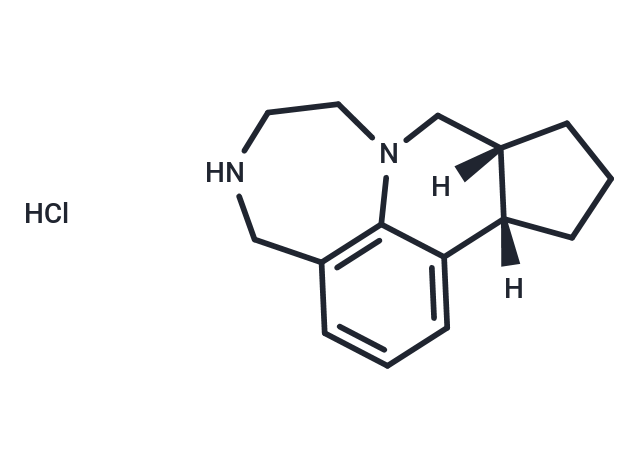Shopping Cart
- Remove All
 Your shopping cart is currently empty
Your shopping cart is currently empty

Vabicaserin hydrochloride (SCA 136) is a selective agonist of 5-hydroxytryptamine 2C (5-HT2C) receptor (EC50: 8 nM).

| Pack Size | Price | Availability | Quantity |
|---|---|---|---|
| 1 mg | $76 | In Stock | |
| 5 mg | $188 | In Stock | |
| 10 mg | $278 | In Stock | |
| 25 mg | $447 | In Stock | |
| 50 mg | $592 | In Stock | |
| 100 mg | $816 | In Stock | |
| 200 mg | $1,080 | In Stock | |
| 1 mL x 10 mM (in DMSO) | $198 | In Stock |
| Description | Vabicaserin hydrochloride (SCA 136) is a selective agonist of 5-hydroxytryptamine 2C (5-HT2C) receptor (EC50: 8 nM). |
| Targets&IC50 | 5-HT2C:8 nM (EC50) |
| In vitro | In Chinese hamster ovary cell membranes, Vabicaserin displaces 125I-(2,5-dimethoxy)phenylisopropylamine binding from human 5-HT2C receptor sites (Ki: 3 nM) and is >50-fold selective over a number of serotonergic, noradrenergic, and dopaminergic receptors. The binding affinity determined for the human 5-HT2B receptor subtype using [3H]5HT is 14 nM. Vabicaserin is a potent and full agonist (EC50, 8 nM; Emax, 100%) in stimulating 5-HT2C receptor-coupled calcium mobilization and exhibits 5-HT2A receptor antagonism and 5-HT2B antagonist or partial agonist activity in transfected cells, depending on the level of receptor expression. Vabicaserin showed a lower affinity at the binding site (22 nM) of 5-HT2C antagonist labeled with [3H]methsulamide. Other binding studies have shown that Vabicaserin has an affinity for 5-HT2B and 5-HT1A receptors with Ki values of 14 and 112 nM, respectively [1]. |
| In vivo | After administering a single oral dose of [14C]Vabicaserin (50 mg/kg in mice, 5 mg/kg in rats, and 15 mg/kg in dogs), the unchanged drug accounted for less than 19%, 20%, and 35% of the total plasma radioactivity in mice, rats, and dogs, respectively, at all examined time points. The carbamoyl glucuronide (CG) comprised approximately 7-36% of plasma radioactivity in mice, 2-28% in dogs, and was absent in rat plasma following the single [14C]Vabicaserin dose, yet observed in rat plasma after multiple-dose administration of Vabicaserin at higher doses, being roughly 20 times lower than Vabicaserin based on AUC0-24 values at steady state. The plasma AUC0-24 ratios of CG to Vabicaserin were 1.5 in mice and 1.7 in dogs post-single dose. At doses used for safety assessment, these ratios at steady state were lower for mice (0.2-0.6) but slightly higher for dogs (1.8-4.0). CG was detected in dog urine at amounts comparable to the parent drug but was not found in mouse or rat urine post-single dose. Following a 5 mg/kg [14C]Vabicaserin dose in rats, 19-24% of the administered dose was recovered in bile over 24 hours, with CG representing up to 30% of biliary radioactivity. In monkeys, after a single oral 25-mg/kg dose of Vabicaserin, CG plasma concentrations surpassed those of Vabicaserin at all examined postdose intervals (2-24 h), though the CG-to-Vabicaserin ratio declined by 24 h postdose, from 17.5 at 2 h to 1.7 at 24 h, indicating that CG is a major metabolite with a 12:1 AUC0-24 ratio to Vabicaserin. |
| Alias | SCA 136 |
| Molecular Weight | 264.79 |
| Formula | C15H21ClN2 |
| Cas No. | 887258-94-8 |
| Smiles | Cl.[H][C@@]12CCC[C@]1([H])c1cccc3CNCCN(C2)c13 |
| Relative Density. | no data available |
| Storage | Powder: -20°C for 3 years | In solvent: -80°C for 1 year | Shipping with blue ice. | ||||||||||||||||||||||||||||||||||||||||
| Solubility Information | DMSO: 55 mg/mL (207.71 mM), Sonication is recommended. H2O: 4 mg/mL (15.11 mM), Sonication is recommended. | ||||||||||||||||||||||||||||||||||||||||
Solution Preparation Table | |||||||||||||||||||||||||||||||||||||||||
H2O/DMSO
DMSO
| |||||||||||||||||||||||||||||||||||||||||

Copyright © 2015-2025 TargetMol Chemicals Inc. All Rights Reserved.